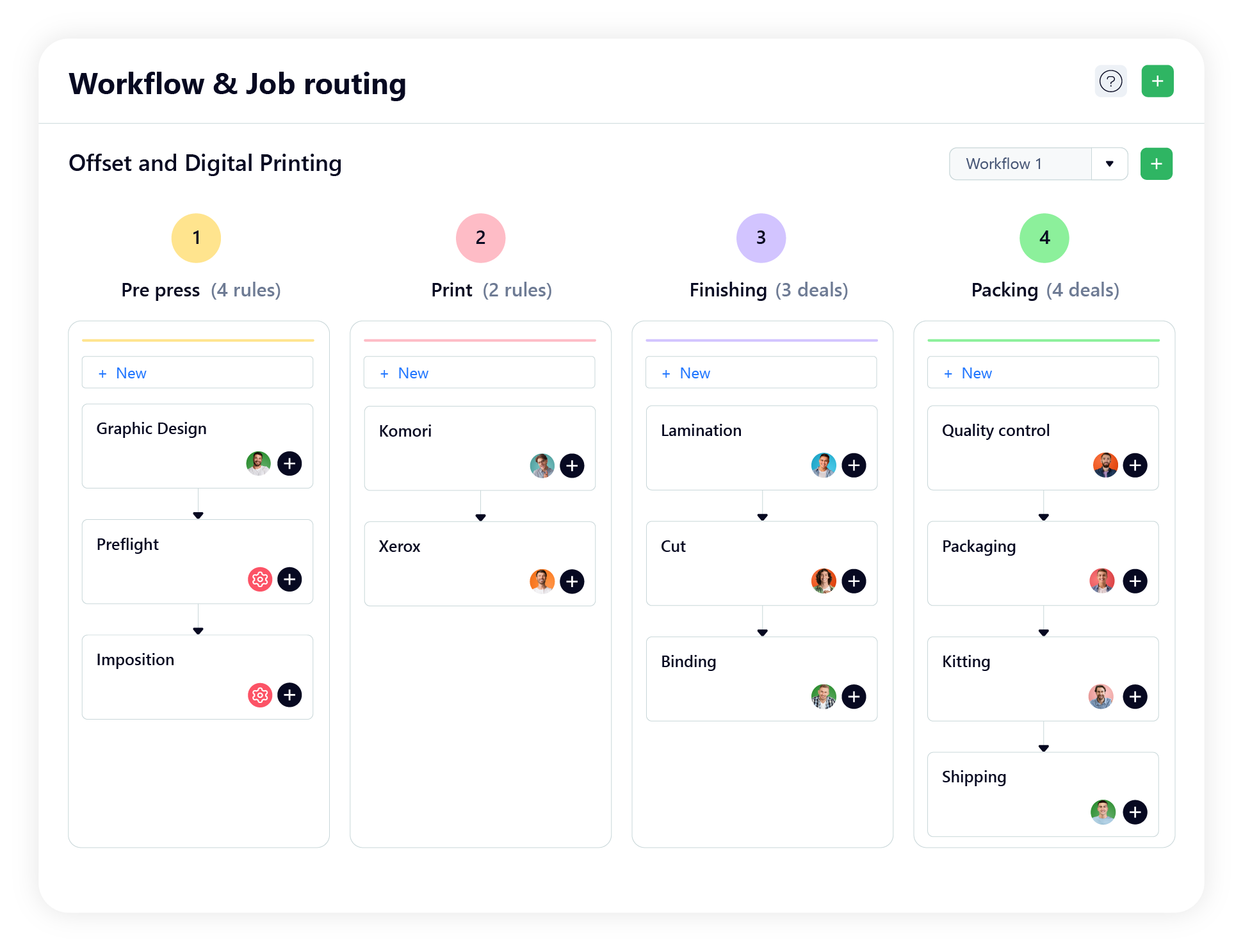How to Create Effective Workflows for Print and Packaging
How to Create Effective Workflows for Printing and Packaging
Introduction
In the printing and packaging sector, the standardization of operational processes is what enables scaling, maintaining quality, and meeting deadlines. However, many production workflows are still managed manually, with informal communications, paper sheets, or simple Excel files, making it difficult to ensure consistency, control, and repeatability.
With Wsc Printer, workflows become digital, configurable, and traceable.
Thanks to Job Routing Templates, you can create predefined production paths for each type of job, automatically assign tasks to operators, and monitor each phase in real time.

Operational KPIs: How Much You Gain with Automated Workflows
- 📋 +70% consistency in workflows
The introduction of Job Routing Templates has allowed many companies to eliminate improvisation in processes. Each job follows a predefined and validated path, with codified phases, clear responsibilities, and consolidated logical sequences. This leads to high operational uniformity among similar orders, reduces variability of results, and improves long-term work quality. - ⚙️ -50% start-up times in departments
Forget last-minute operational briefings or waiting for instructions. Thanks to digital workflows and pre-configured job tickets, operators immediately receive all necessary information (machine, processing, materials, times). This accelerates start-up and allows more orders to be put into production in less time. - 📌 +60% efficiency in managing internal transitions
Cutting, printing, folding, packaging... each phase is guided by rules and digital checklists. Tasks are notified to the next department only when the previous one is completed and validated, avoiding overlaps, doubts, or incomplete processing. Transition efficiency between phases improves significantly. - 🔁 +35% reduction in operational errors
Errors due to unclear instructions, subjective interpretations, or operational forgetfulness are drastically reduced. Templates associated with each type of job include standard instructions, correct materials, and visual references: operators no longer have to ask but can act immediately with confidence. - 📈 +90% visibility on work progress
Every planned activity is monitored and updated in real time, with dashboards showing the status of orders, resource workload, and potential delays. The production manager has complete control over everything happening and can intervene before a problem becomes a blockage. - 📎 100% traceability of completed tasks
Every single phase carried out is recorded: who performed it, when, on which machine, and with what outcome. This not only allows for the reconstruction of each job in case of a complaint or audit but also fosters a culture of continuous improvement and operational accountability.
From Chaos to Clarity: The Power of Automated Workflow
- 🔧 Creating customized workflows for each type of product, process, or customer
Each type of job – from large-scale offset printing to small digital productions – may have different operational requirements. With Wsc Printer, you can configure specific workflows for each product category, customer, or processing type. This ensures that each job follows the optimal path, avoiding mistakes and improving quality. - ⏱ Elimination of downtime between phases, thanks to the automatic transition of tasks
When one operation is completed, the system automatically activates and notifies the next one, without the need for manual intervention. This eliminates idle moments between departments and drastically reduces delays due to lack of communication or waiting. - 🧑🏭 Dynamic task assignment based on role, machine load, or priority
Tasks are no longer distributed randomly. The system assesses workload, operator skills, and urgencies, assigning each task to the most suitable resource at the right time. This balance optimizes resource use and accelerates production times. - 📋 Integrated operational checklists for each process, accessible even from shop floor terminals
Each production phase can include digital checklists that guide the operator step-by-step, reducing the chances of errors. Checklists are accessible directly from touchscreen terminals on the shop floor or from mobile devices, making interaction simple and immediate. - 📤 Automation of job ticket distribution to machines and operators
Once approved, job tickets are automatically sent to the department and involved machines. There’s no longer a need to print or transcribe anything: instructions arrive already complete with layouts, materials, and parameters set, ready for execution. - 📊 Continuous monitoring of production status and performance
Each task performed is recorded and associated with real-time KPIs. This allows for monitoring individual performances, machine saturation, work progress, and anomalies. Managers can promptly intervene and constantly improve operational performance.
How Much Does Every Process Error Cost You?
- 🛑 Misaligned workflows between departments
When each department follows different rules or uses disconnected tools, processes become misaligned. This leads to forgotten steps, duplicated or out-of-sequence tasks, slowing down production and creating confusion among teams. - 📄 Incomplete or difficult-to-interpret job tickets
Without a centralized and visual system, operational instructions risk being incomplete, ambiguous, or distributed in different formats. This leads to machine downtime, operational errors, and the need for rework. - 🔇 Lack of visibility on ongoing tasks
If you don’t know what has been done, by whom, and the status of an order, it’s impossible to react in case of problems. Anomalies are detected too late when the damage is already done. - 🔁 Continuous repetition of operational briefings
Without digital workflows and automatic task assignment, managers must continuously explain priorities, changes, and urgencies. This wastes valuable time that could be used for supervision and continuous improvement. - ❌ Processing errors due to non-standardized instructions
Oral instructions, handwritten notes, or personal annotations generate confusion. The lack of standards leads to inconsistent execution, non-conformities, and often the complete repetition of a phase. - 💸 Waste of paper, time, and materials
Every communication error, every wait between phases, every rework not only slows down production but generates measurable waste in euros, materials, machine time, and human resources. - 📉 The impact on numbers
Companies that do not standardize workflows lose up to 12% of their potential productivity, according to Wsc Printer internal studies.
They also record on average over 20% of avoidable rework due to process errors and lack of control. - 🔍 In a company with 4 active production lines, this can equate to tens of thousands of euros per year in lost margins, wasted man-hours, and unused materials.
The Concrete Solution for Organized Production
In the competitive landscape of printing and packaging, it is no longer enough to simply "follow" operational flows. You must lead them, anticipate them, and control them at all times.
With Wsc Printer, production is no longer a set of disconnected tasks but a structured, intelligent, and responsive ecosystem.
Thanks to Job Routing Templates, you can design and optimize every process visually, dynamically, and perfectly adapted to your way of working.
- 🎯 With Wsc Printer you can:
- ✅ Standardize every production phase with precise sequences, checklists, and operational rules
- ✅ Distribute tasks efficiently based on machine load, priorities, and operator role
- ✅ Connect resources, operators, and machines into a single synchronized and transparent flow
- ✅ Track every activity, every step, every action performed, ensuring complete traceability
- ✅ Intervene in real time in case of anomalies or delays, thanks to control dashboards and automatic alerts
- ✅ Increase punctuality, quality, and profitability, transforming production from a cost center into a competitive advantage
🔁 From order to delivery, every process is under control.
There is no more room for improvisation: every phase is visible, optimized, and replicable.
⚙️ Your production no longer reacts to the flow.
Your flow follows your strategy.
Operational Answers to Your Routing Doubts
- How can I create different workflows for different clients or products?
- With Wsc Printer you can define specific workflow templates for each type of product, client, or recurring order. Each template includes the phases to follow, automatic assignments, materials to use, and operational rules, customizable via a drag & drop interface.
- Can the processing templates be reused or duplicated?
- Absolutely yes. You can save a workflow as a reusable template, duplicate it, and modify it for similar jobs. This helps standardize processes, reduce planning times, and maintain operational consistency across similar or recurring orders.
- Is it possible to monitor phase progress in real time?
- Yes. Each phase of job routing can be monitored via dashboards. You can see what has been completed, what is delayed, and who is responsible for each task, in real time.
- Can I connect workflows directly to machines or shop floor terminals?
- Of course. Job tickets generated by templates are automatically distributed to digital printers, offset machines, or touchscreen devices in the shop floor. Operators receive instructions directly on the terminal and update the phase progress there.
- How are extra or non-standard operations managed?
- You can integrate manual phases or exceptional approvals into the workflow. Moreover, each workflow can be modified even during execution, without losing process tracking. This ensures operational flexibility without compromising traceability.
- Does the system send notifications in case of delays or blocks?
- Yes. You can configure customized alerts in case of expired, inactive, or abnormal tasks (e.g., missed task, missing material). Notifications are sent to involved users via email, internal system, or visual dashboard alerts.
- Is it possible to integrate workflows with existing ERP or management software?
- Yes. Wsc Printer is designed to easily integrate with ERP, MRP, CRM, or other systems via REST API, webhook, or custom connectors. This ensures centralized and consistent data management.
- Is there a complete history of executed tasks?
- Every activity is recorded: who performed it, when, on which machine, and with what outcome. The history can be filtered by date, job, client, department and is crucial for internal audits, performance analysis, or customer complaints.
Conclusion – From Order to Result, in Total Control
In the world of printing and packaging, competitiveness is not only about price or speed but the ability to coordinate every phase with precision, efficiency, and strategic vision.
- 🕒 reduce time and waste
- 📦 improve punctuality
- 📈 increase profitability
- 🤝 offer impeccable service to your customers
With Wsc Printer, these three areas merge into a single intelligent and integrated platform capable of connecting people, machines, and data in real time.
Every job starts on the right foot.
Every department works in sync.
Every customer receives exactly what they expect — on time and with the promised quality.
💡 The future of Print & Pack production is not just faster. It’s smarter.

Get weekly updates
in your inbox!




